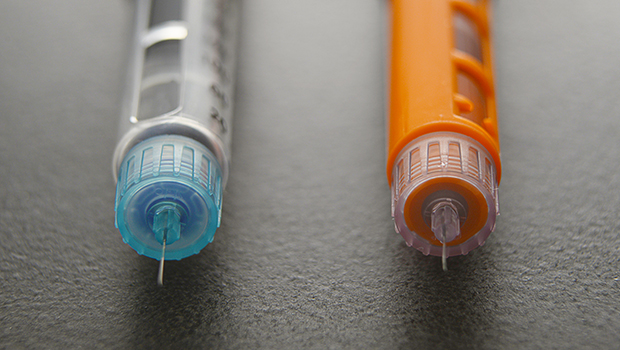Novo Nordisk Hopeful for FDA Clearance for Weekly GLP-1 Injectable

Novo Nordisk, maker of the widely-prescribed daily dose GLP-1 Victoza (liraglutide) T2D glucose control injectible, first introduced in the U.S. in January 2010, has moved a step closer to obtaining Food and Drug Administration clearance for its weekly dose formulation semaglutide. On October 18, the FDA’s Endocrinologic and Metabolic Drugs Advisory Committee voted to recommend regulatory approval of semaglutide as an adjunct to diet and exercise for glycemic control in adults with type 2 diabetes. The drug is undergoing regulatory review in Japan and before the European Medicines Agency as well. Novo also has an oral formulation of the drug in investigational study.
Extensive clinical study and trialing begun in the early 2000’s has established the superior efficacy of the GLP-1 class of drugs, which have been developed by several manufacturers, in lowering A1c compared to oral T2D medications. Subsequent trials showed the drugs to be safe for use by patients with established cardiovascular disease and also to aid in controlling weight.
Initially developed for delivery by once or twice daily injection, drugs in the class have been reformulated to extend their release times. Novo’s entry in the longer-acting category reaches its maximum concentration in the body by the third day following injection. As T2N reported in December 2015 on semaglutide’s early trial results, the manufacturer believes that eliminating the need for daily injection reduces the likelihood and severity of gastric distress or pancreatitis, side effects reported among some users of daily or twice daily dose products.
And, as Novo pointed out in its written submission to the committee, many people who have T2D require treatment intensification as their conditions progress, often in the form of additional oral agents or adoption of insulin therapy. Treatment regimens that become more complex or inflexible undermine patient adherence to self-care requirements and result in failure to achieve desirable A1c targets. “A requirement of multiple injections is a perceived burden in T2D patients, and once-weekly (dosing) may improve patient adherence and health-related quality-of-life, compared with daily formulations, as has been demonstrated with less frequent dosing for patients with other chronic illnesses,” Novo argued in its committee presentation.
In all, approximately 9,400 individuals had participated in 25 safety and efficacy trials of Novo’s long acting GLP-1 formulation, with about a third of participants recruited in the U.S., at the time the manufacturer submitted its new drug application to FDA in December 2016. A month ahead of the filing, fifteen of the investigators conducting the 3,297-participant SUSTAIN-6 trial co-authored an article published in the New England Journal of Medicine in which they noted that participants using semaglutide had experienced lower incidence of adverse cardiovascular outcomes compared to those using a placebo, but they stopped short of claiming a statistically provable cardiovascular risk reduction benefit.
As T2N reported on September 5, the LEADER trial of Novo’s Victoza product begun in 2010 demonstrated that among its longer term benefits had been a lowering of risk of heart attack and stroke among users who had established cardiovascular disease. The findings led to a change in Victoza’s FDA-approved prescribing information in August 2017 to add that benefit as an indicated use.
SUSTAIN-6, on the other hand, was designed to demonstrate that semaglutide would not raise risk of an adverse cardiovascular outcome by a factor of 1.8 or more, as set in trial design guidance given by FDA. The trial did show, nevertheless, that compared to the placebo, semaglutide lowered cardiovascular risk by 26% overall. Risk of stroke dropped by 39% and risk of heart attack by 26%, but the investigators considered the heart attack number not to be significant. A cardiovascular outcome study with a larger population of participants is planned. Novo hopes that results will better measure the full extent of the drug’s cardioprotective benefits.
It is not yet conclusively known how GLP-1 drugs benefit cardiovascular health. One school of thought is that in effectuating better glycemic control than has been possible with the traditional oral medications, GLP-1 drugs can better prevent or delay onset of cardiovascular problems associated with progressing T2D. Another theory is that GLP-1 drugs may play a role in lowering the concentration of triglycerides, fats stored in the body for fuel, which are known in high concentration to increase the risk of heart attack and stroke, and which are usually present at elevated levels in people who are obese or have poorly controlled diabetes. A third view is that the drug’s body weight reducing benefit would quite normally be expected to bring about overall improvement in health, particularly to reduce stress to the heart and circulatory tissue.
Medications that bring on rapid or steep lowering of blood glucose levels, including some insulins, have been known to trigger changes in retinal blood vessels indicating the onset – or worsening – of diabetic retinopathy in patients who have long established T2D. In its review the advisory committee also addressed an apparent worsening of signs of diabetic retinopathy observed in approximately 3% of the semaglutide users in the SUSTAIN-6 trial compared to just under 2% of those taking the placebo. In its briefing materials for the advisory committee the FDA staff included a detailed opinion rendered by ophthalmologist Wiley A. Chambers, MD describing dissimilarities among the diabetic retinopathy examinations performed upon trial participants, and dissimilarities among participants themselves as to baseline A1c and duration and progression of T2D and associated complications, that combined to render the results inadequate “to be able to appropriately capture clinically significant (diabetic eye disease) events and analyze them.” Moreover, FDA staff contended before the committee, the long term benefits of improved glycemic control to eye health outweighed the far shorter term risk of onset or worsening of diabetic retinopathy following initiation of treatment.
Although the agency is not bound by recommendations of its drug advisory committees, it does typically follow them in taking final action on a new drug application. How the diabetic retinopathy concern will be addressed, by way of warning or other information included in the product’s prescribing information, is likely to be specified in the NDA (new drug application) Approval Letter, which could be issued as early as December.
Want more news on Type 2 diabetes? Subscribe to our newsletter here.





